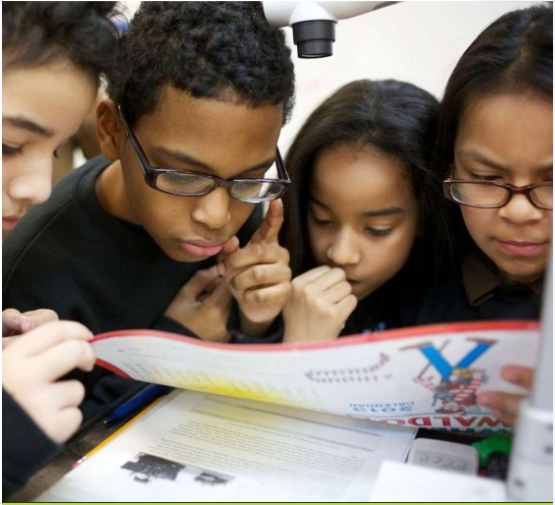
Editor’s note: This post from Bruno V. Manno, senior adviser to the Walton Family Foundation’s K-12 Program and a reimaginED contributor, appeared Friday in the The Messenger.
A wide-ranging national study of U.S. charter schools presents more evidence that this nonprofit enterprise sector of public education is largely a success story. Charter students have reading and math test score gains that are greater than their peers in traditional district public schools, learning an additional 16 days in reading and six days in math. Overall, 83% of charter students perform the same or better than their district peers in reading and 75% perform the same or better in math.
The Center for Research on Educational Outcomes (CREDO) at Stanford University has published three reports since 2009 on the charter sector’s academic successes and struggles — the third was released on June 6. Like other analyses, CREDO’s report shows continuous improvement in charter student academic outcomes over time. CREDO further shows that this progress comes from existing schools getting better, rather than better new schools raising the performance of existing schools.
The general lesson for American K-12 education is that public schools can change a student’s learning path and accelerate academic growth. This is good news as public education seeks ways to solve the problem of pandemic-related learning loss.
To continue reading, go here.

Ashley Elliott of Florida and her principal after her high school graduation. Elliott now serves as coordinator of the Future Leaders Program at the American Federation for Children.
Editor's note: This commentary by Mark LeBlond, policy director of EdChoice, was originally published in the Washington Examiner.
Ashley Elliott was one of the “hard cases.”
Born addicted to drugs and raised by her single grandmother, life was hard for Ashley. She struggled in school — until 10th grade. After years of fighting, bullying, and poor grades, Ashley found refuge in Lakeland, Florida , when a private Christian school admitted her on a tax credit scholarship. There she found teachers who cared about her, who believed in her.
In turn, Ashley began to believe in herself. Ashley thrived, graduating high school, then college, and embarking upon adulthood as an education advocate.
A thousand miles to the north, Pennsylvania policymakers are grappling with a related policy problem. How can the government guarantee a thorough and efficient education to all students, regardless of their background, socio-economic status, or zip code?
In a case dating back to 2014, William Penn School District v. Pennsylvania Department of Education, the plaintiffs argued the state fell short of its constitutional guarantee, and further, that an overhaul of the school funding system is the only solution. After years of wrangling over the role of money in Pennsylvania public education, the courts finally ruled earlier this year.
The Commonwealth Court ruled that Pennsylvania’s present education funding model is broken, yet stopped short of prescribing a fix, instead leaving solutions to the legislature and governor. In her opinion, Judge Renee Jubelirer emphasized that reform does not have “to be entirely financial ... The options for reform are virtually limitless. The only requirement, that imposed by the Constitution, is that every student receives a meaningful opportunity to succeed academically, socially, and civically, which requires that all students have access to a comprehensive, effective, and contemporary system of public education.”
To continue reading, go here.
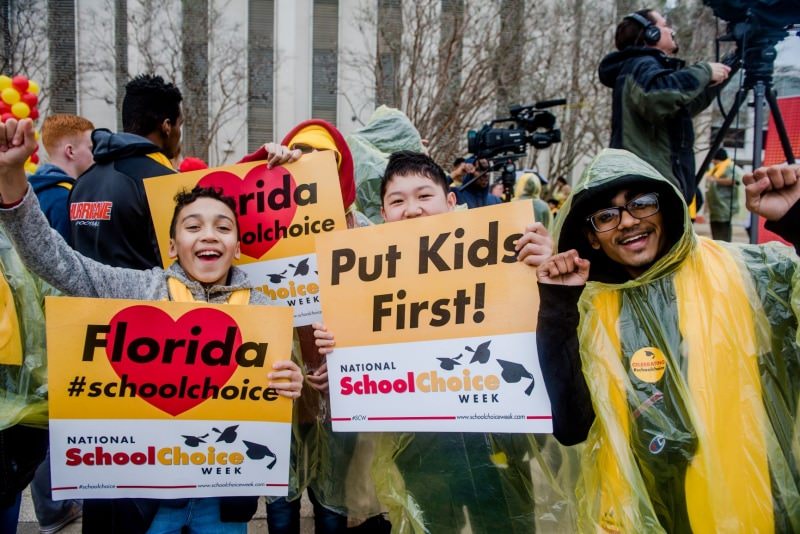
Nearly half of all parents are seeking new schools for their children in the 2023-24 school year. The data comes from a new survey by National School Choice Week, which found that 45.9 percent of parents want to enroll their child in a different learning environment this fall.
Of those parents, about 17 percent are still considering their options; 13 percent enrolled their student in a new school; 8.4 percent applied, and 7.5 percent chose homeschooling. That leaves 54 percent of parents keeping their child in their current school.
Though just under half of all respondents wanted to enroll their student in a new school, minority parents were far more likely to seek options than white ones. Black parents (60 percent) were far more likely to search for new school options than white parents (39 percent). Most Hispanic parents (53 percent) also sought new options.
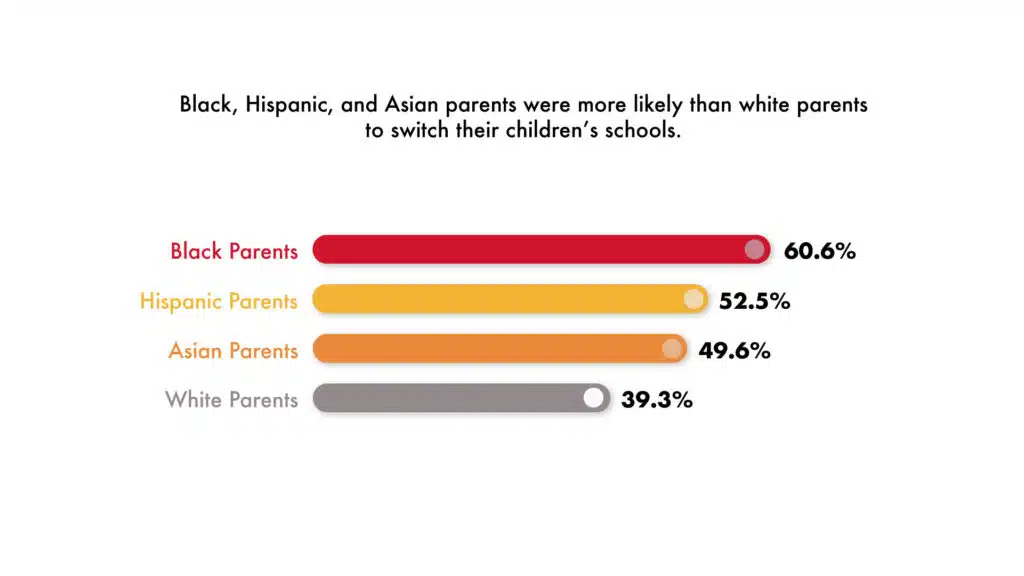 Despite the large number of parents who are seeking to change schools, many thought schools were as good as or better than last year. About 45 percent of parents thought their student’s education was better than last year; 34.4 percent thought it was about the same and just 20.5 percent thought it was worse.
Despite the large number of parents who are seeking to change schools, many thought schools were as good as or better than last year. About 45 percent of parents thought their student’s education was better than last year; 34.4 percent thought it was about the same and just 20.5 percent thought it was worse.
Wealthier parents, not surprisingly, were more satisfied with their educational choices than lower income parents.
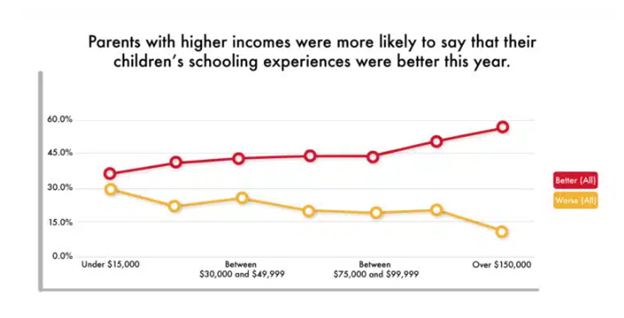
The survey, by National School Choice Week, was conducted in May 2023 with more than 2,400 parents responding. Check out the full survey here.
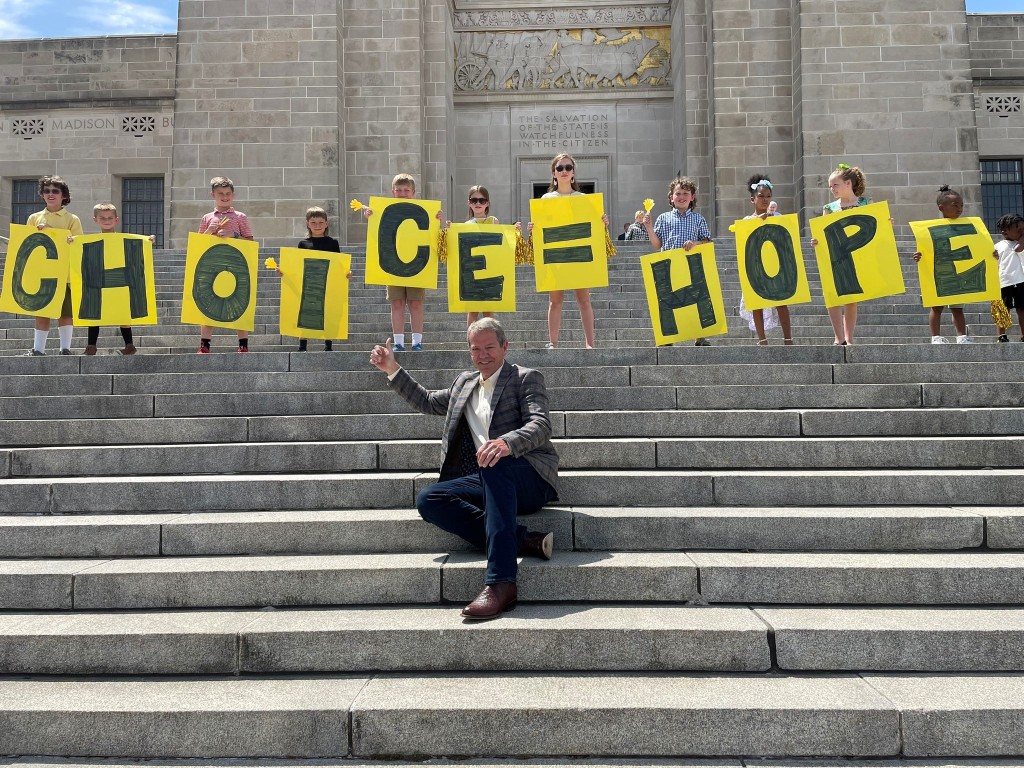
Editor's note: On May 30, Nebraska Gov. Jim Pillen signed legislation establishing the first education choice program in the state's history. The passage met with immediate resistance from opponents, who are working to repeal the program by gathering enough signatures to put the measure on the 2024 ballot. They need to get about 61,000 valid signatures from registered voters within 90 days to do so.
A committee of community leaders and elected officials in Nebraska known as Keep Kids First has launched a decline to sign campaign in response to the teachers union’s attempt to repeal recently passed LB753 – the Opportunity Scholarships Act.
Nebraska’s first school choice program, LB753, which was supported by Gov. Jim Pillen and a supermajority of state senators, will provide scholarship opportunities for students from lower-income and military families, students who have special needs, students who have been bullied, students who are in the foster care system, and students who have been denied public school option enrollment.
For more than a decade, advocates and families have been fighting to pass a school choice program in Nebraska. Those efforts have consistently been met with resistance from special interest groups like the NSEA – the state’s teachers union.
Keep Kids First says it will work to educate Nebraska voters about the Opportunity Scholarships Act, correct misinformation about the program from the teachers union and their well-funded political allies, and urge Nebraskans to decline to sign the petition. Initial members of Keep Kids First include Senators Lou Ann Linehan, Justin Wayne, Dave Murman, Rob Clements, Tom Brewer and Joni Albrecht, as well as community leaders Clarice Jackson, Omaha; Dr. Britt Thedinger, Omaha; Kim Schroll, North Platte; and John M. Dinkel, Norfolk.
On May 30, the 33 state senators who voted for the bill released a statement: “We are deeply disappointed that some in the Nebraska public education establishment are pursuing a multi-million dollar ballot initiative denying opportunities to vulnerable and at-risk children.... We stand united with families and students and are committed to defending the educational opportunities created by the historic passage of the Opportunity Scholarships Act.”
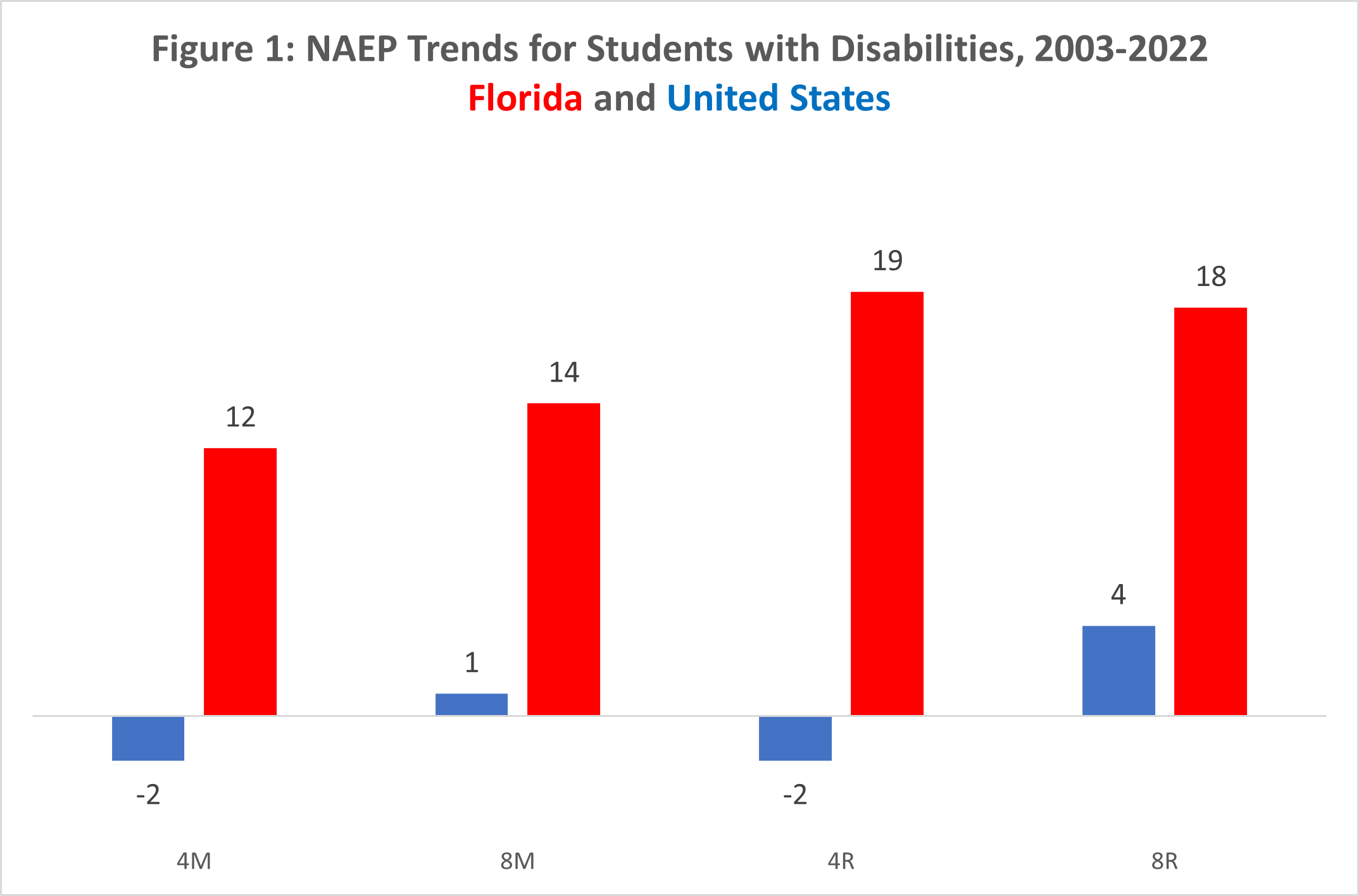
If you take the Nation’s Report Card data back as far as it will go to capture all 50 states (2003) and up until the most recent exams (2022), the trends for students with disabilities look like the chart above. For the United States across four exams you get a net 1-point increase. Let’s call that the midpoint between “spinning your wheels” and “playing in your food” spectrum. Meanwhile Florida made a net 63 points of progress, a grade level or more on each of the exams. A suite of reforms seems to have helped drive this progress.
Florida Gov. Jeb Bush’s reforms started in 1999 and included the creation of the nation’s first private choice program for students with disabilities. You can examine Figure 1 above and ponder whether the continual predictions of doom made by choice opponents seem the
least bit credible. Florida lawmakers created a separate education savings accounts, or ESA program, for students with unique abilities before consolidating the programs. Florida’s students with disabilities have had more choice access for a longer period of time than students in any other state.
Florida’s policies with a plausible connection to academic progress for students with unique abilities don’t end with choice. Florida pioneered the grading of schools A-F. Crucially, the Florida formula double weights the academic gains of the bottom 25% of students on the previous year’s state standardized exams.

Among Ilen Perez-Valdez’ many accolades: National Honor Society member, Immaculate-LaSalle’s Spanish Honors Society president, Science Honors Society vice president, and English Honors Society treasurer.
MIAMI – Nery Perez-Valdes wanted to become a doctor, but life got in the way.
She fled Cuba for Miami with her mom when she was 11 and found herself working at 14 to help pay the bills. Nery would become a single mom and for a long stretch worked two jobs to keep the lights on and food on the table.
Nery always wanted a private school education for her daughter, Ilen, and a Florida Tax Credit Scholarship made possible by corporate donations to Step Up For Students allowed that to happen.
“I was a single mom since I was three months pregnant, and when I’m saying, ‘single mom,’ I’m telling you ‘single mom.’ No child support. No help. No nothing. Period. The end,” Nery said. “Thanks to Step Up For Students, Ilen was able to get the education I wanted for her.”
Ilen has made the most of that opportunity – and then some.
She graduated this spring near the top of her class at Immaculate-LaSalle High School, a prestigious Catholic school in Miami. She has a scholarship to the University of Miami and plans to major in neuroscience and double minor in business administration management and Spanish. Her goal is to attend medical school and become a pediatric oncologist.
“My mother never received a college education. She was barely able to graduate high school. All she has done since she got (to the United States) is work, work, work,” Ilen said. “She came here looking for the American dream. I feel like if I succeed, she can live out her American dream through me.”
Ilen has received a Florida Tax Credit Scholarship since kindergarten. She said she’s grateful for the opportunity to receive a quality education – first at Saint Agatha Catholic School, and then at Immaculata-LaSalle.
“It was really difficult to make ends meet when I was younger, so I wouldn’t have been able to attend a private school where I received such an excellent education,” she said.
To continue reading, click here.

Crown Point Christian School in St. John, Indiana, is one of about 650 private schools in the state. Committed to academic excellence, Crown Point trains children to understand the world around them and to recognize that "every part belongs to God."
Editor’s note: This article appeared Tuesday on stateaffairs.com.
Eligibility for Indiana’s school choice voucher program is poised to dramatically increase next school year, enabling roughly 97% of students to use state money to attend private schools, according to school choice advocates.
State lawmakers have slowly expanded the program since they implemented it more than a decade ago. The state released its annual school choice report last month which provides insight into where the program stands ahead of arguably its largest expansion to date.
Already, between the 2021-2022 school year and the 2022-2023 school year, the cost to state taxpayers for the program grew by 30%, the report shows. That’s before the latest eligibility expansion goes into effect.
The 2022-2023 school year was the state’s largest increase in the number of students claiming vouchers since the 2014-2015 school year.
This past school year, a family of four had to earn around $154,000 per year or less for a student to qualify to receive state money to attend a private school. In the two-year state budget passed in April, lawmakers expanded the eligibility to allow those making 400% of the income required to qualify for free or reduced-price lunches to participate in the school choice program.
Likewise, state lawmakers simplified eligibility by removing other requirements.
That means a family of four earning up to $220,000 per year will qualify this upcoming year, including students who have already been attending private school on their family’s own dime. Robert Enlow, the president and CEO of EdChoice, called Indiana’s program “effectively universal.”
“It’s unfair to pay twice, once in taxes and once in tuition,” Enlow said. “[The new policy has] basically said to almost every parent in the state of Indiana that we trust your choices.”
Costs for the program are expected to balloon by more than 70% in the first year. By fiscal year 2025, the state will spend an estimated $600 million on vouchers per year.
To continue reading, click here.
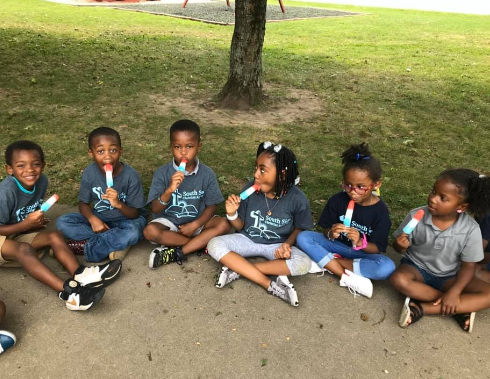
Serving students on the south side of Peoria, Illinois, an area that struggles with high unemployment, poverty and crime, South Side Christian Academy is a “faith-funded school,” self-described as one with faith that God will provide the funds needed to educate students.
Editor’s note: This commentary from Keri D. Ingraham, a fellow at Discovery Institute, director of the American Center for Transforming Education, and a visiting fellow at the Independent Women’s Forum, appeared earlier today on washingtonexaminer.com.
On the heels of a historic year of school choice advancement, including legislation that enacted universal or near-universal school choice programs in seven states, Illinois is poised to go in the opposite direction, delivering a blow to low-income families.
Specifically, the Democratic-controlled legislature in Illinois is positioned to let the Invest in Kids $100 million tax-credit scholarship program, enacted in 2017, sunset at the end of this calendar year. The action will nix a school choice program currently providing educational options to 9,000 low-income students.
As a tax-credit scholarship, the school choice program is not directly funded with taxpayer dollars but is privately funded by people and businesses who contribute through a qualified scholarship-granting organization.
Regardless, state lawmakers intentionally opted not to extend the program during the spring legislative session by failing to include it in the state’s budget implementation bill. Several other bills introduced during the session that would have extended the program also failed.
According to Myles Mendoza, founder and former President of Empower Illinois, the organization that led the inception of the tax credit scholarship policy, “despite daily pleas throughout the legislative session to extend the school choice program from parents, grandparents, foster parents, and guardians of children receiving the tax credit scholarship, Democratic House Speaker Chris Welch didn’t seem to even notice.”
The Democrat lawmakers’ loyalties lay with the public school teachers unions, who are stark opponents of school choice because having more children enrolled in public schools increases teacher staffing levels, equating to more members’ dues into union coffers, and who spend millions of dollars fueling Democratic political campaigns every year.
It’s a vicious funding cycle, with Democrat politicians and teachers union leaders pledging unwavering allegiance to each other in this quid pro quo relationship. Clearly, the importance of providing low-income students an opportunity to receive a better education pales in comparison.
But there was another reason the teachers unions pressured Illinois’ Democratic lawmakers to ensure the school choice program ends: The program shed a glaring light on the magnitude of parents seeking to free their children from the failing union-controlled Illinois public schools.
According to test data released by the Illinois State Board of Education, a startling 70% of Illinois public school students fail to read at grade level, and 75% fail to meet proficiency in math.
To continue reading, click here.
 A new study from a professor of economics in the Gatton College of Business and Economics at the University of Kentucky finds positive correlation between states’ K-12 student achievement and their education choice policies.
A new study from a professor of economics in the Gatton College of Business and Economics at the University of Kentucky finds positive correlation between states’ K-12 student achievement and their education choice policies.
According to the paper, “Enhancing economic freedom via school choice and competition: Have state laws been enabling enough to generate broad-based effects?” released in early May, states with school choice programs saw large improvements in statewide test scores.
The report follows a study released earlier this year from Patrick J. Wolf, Jay P. Greene, James D. Paul and Matthew Ladner that shows similar results.
“This paper’s basic findings indicate strikingly large fourth grade reading and math test score gains for states that have adopted voucher programs and/or Education Savings Accounts,” wrote the researcher, John Garen.
The study shows that charter schools produced positive test score improvements, though only if the state’s enabling charter school law was not deemed “restrictive.”
Additionally, Garen found that increases in per-pupil spending correlated with improved test scores, but this impact was significantly smaller than offering a voucher or education savings account.
The paper compared National Assessment of Educational Progress (NAEP) scores from 1992 to 2019 and to the availability of school choice programs and the restrictions on student eligibility, as well as scholarship funding. However, the research did not include home education or district open enrollment policies in the results.
The study also considers whether school choice laws permit or restrict enrollment and new school entry, total public school per-pupil spending, and adjusts for the student’s race, income and learning disability status.
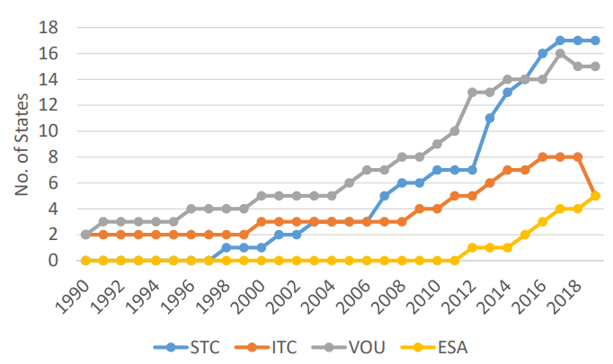
The number of states offering private school choice programs has grown steadily over the last two decades. (Scholarship Tax Credit (STC), Individual Tax Credit (ITC), Voucher (VOU), Education Savings Account (ESA))
According to Garen, for every $1,000 increase in per-pupil spending, there was a corresponding increase of 0.25 points in reading and 0.14 in math.
States with charter schools, however, saw decreases in both math and reading scores, but this may be impacted by restrictive charter school laws. States with less restrictive charter school laws, which would allow more students and schools, saw an increase of 0.65 points on the NAEP, the equivalent of increasing per-pupil spending by $2,500.
A statewide voucher program improved reading by 2.25 points, and the education savings account improved reading scores by 3.46 points, an effect that is 13 times stronger than simply increasing per-pupil spending.
Math scores also improved significantly in states with voucher and ESA programs. According to the researcher, the effect of an ESA program on statewide math scores was 27 times stronger than increasing per-pupil spending by $1,000.
States with ESA programs observed in the study include Arizona, Mississippi, North Carolina, Tennessee, and Florida.
Here are some additional findings:
According to Garen, vouchers and education savings accounts were better funded than tax credit scholarships but funded less than traditional public schools.
“Such programs,” the research concludes, “are associated with large improvements in Grade 4 reading and math NAEP test scores and are much bigger than the effect of school funding. Moreover, they are associated with lower school costs, implying a double dividend of better outcomes at lower cost.”
The report was published May 1.

The Oceti Sakowin Educational Learning Center in Rapid City, South Dakota, is a Lakota-led microschool founded on Indigenous education principles and one of many educational environments recognized by The Canopy Project that are designing more equitable, student-centered experiences.
Where are the nation’s most innovative schools, and what are they doing that distinguishes them from the rest of the pack?
The Center for Reinventing Public Education and Transcend, two nonprofit organizations that support innovation in education, has put together The Canopy Project, a comprehensive public database of 251 schools that include district, charter and independent schools and microschools, all with core practices that raise the level of student-centered learning.
The project began in 2019 as a joint effort between Transcend and the Christensen Institute and is fueled by participation from hundreds of organizations and schools.
Last year’s report focused on the increasing number of programs developed for underserved populations who have historically been marginalized, such as students with disabilities. The year before that focused on creative ways of educating students during the challenges posed by the coronavirus pandemic.
A full report on this year’s project won’t be released until this fall, but analysts have already noted the following trends:
Other findings from the survey of leaders at these innovative schools show that three-quarters of them are focusing on developing a sense of community among students.
About 61% have designed advisories where groups of students meet regularly with adult advisers to set learning goals, reflect on progress, and build relationships. Some report increased mental health supports and train adults to recognize and respond to students who are impacted by traumatic stress, and pair students with an adult in school for regular individualized mentoring.
Almost two-thirds of schools reported the use of self-directed learning. This model allows students to set and pursue learning goals largely without adult supervision. About the same number reported an emphasis on practicality, with students learning topics and skills that directly relate to their lives and the world around them.
The survey also showed that 57% are offering learning beyond academics and college prep through career-focused opportunities such as practice job interviews and apprenticeships, while about half were providing learning though community service.
The report is searchable by state, by type of schools, by innovations employed or by student demographics. A user guide explains how to access and filter the data. The organizers hope it will be useful for policy makers, potential donors, and journalists, but most important, educators and entrepreneurs seeking to boost innovation.
“A redesigned school is far easier to imagine than implement. But too often, pessimism about the potential for change persists because educators, leaders, and families can’t picture what viable alternatives would look like,” wrote Chelsea Waite, senior researcher at CRPE and team leader on The Canopy Project, who introduced this year’s project in The 74.
“Amplifying the efforts of hundreds of schools designed to be equitable and student-centered is an exercise in optimism. Canopy offers hope that all kinds of schools can deliver on what students and families value most.”